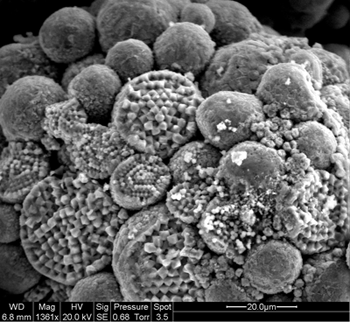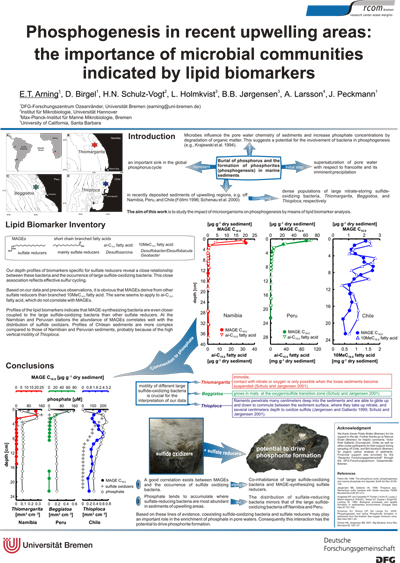News from FROMAGE Members
|
Links to concrections photos on the Web.
Peter Mozley's photo page: http://www.ees.nmt.edu/Geol/GeoPhotos.html Imatra Stones: http://www.koulut.imatra.fi/vnlukio/polut/0/imatrankiveteng.html A possible capture of molybdenum during early diagenesis of dysoxic sediments Tribovillard N., Lyons, T.W., Riboulleau,A., Bout-Roumazeilles, B., 2008.
(find here the high res image) Molybdenum is a trace metal commonly used as a marker of paleoredox conditions of ancient depositional settings. Pyrite is an important Mo host for enriched sedimentary rocks. In this paper we study the relationship between Mo and pyrite in the Bancs Jumeaux Formation, a Jurassic succession in northern France consisting of limestone and pyrite-rich marls. This formation is relatively enriched in Mo compared to other redox-sensitive trace metals. Our approach is grounded on bulk rock chemical analysis and delineation of two contrasting types of pyrite that can be extracted from the rocks: polyframboids and nonframboidal concretionary masses. The morphological characteristics of both morphotypes were studied using scanning electronic microscopy. The polyframboids are richer in Mo than the concretions but are not markedly enriched in other trace metals. This discrepancy in geochemical composition could result from pyrite precipitation at different times during early diagenesis. Our results tend to indicate that the polyframboids would have formed very early in reducing "microniches", within dominantly dysoxic sediment. This early pyrite precipitation occurred at shallow depth below the sediment-water interface close to the abundant Mo source in overlying oxic seawater (molybdate ions), and would have fostered Mo-capture by the polyframboids in relatively large amounts. The concretions would have formed later during early diagenesis (within the sulfidic zone) under conditions of more limited Mo availability. Phosphogenesis in recent upwelling areas: The importance of microbial communities indicated by lipid biomarkers E.T.ARNING, D.BIRGEL, H.N.SCHULZ-VOGT, B.B. JØRGENSEN and J.PECKMANN
The burial of phosphorus and the formation of phosphorites (phosphogenesis) in marine sediments represent an important sink in the global phosphorus cycle. Numerous basin-scale phosphorite deposits were formed in the geological past (e.g., Trappe 1998). Phosphogenesis is not only found in ancient settings, it is reported in recent sediments of upwelling regions as for example off Namibia, Peru, and Chile (Föllmi 1996). Gareth Law
If metal proxies are to be confidently used in palaeo–environmental research, then as a prerequisite, metal behaviour within the modern ocean must be fully understood. In view of this ethos, my PhD research aims to address the influences of (1) bio-mineralisation, (2) Fe/Mn cycling and (3) bioturbation; on trace metal behaviour within the sedimentary environment. My investigations have focused on metal dynamics throughout the Arabian Sea Oxygen Minimum Zone and within a stratified Scottish Sea Loch (Loch Etive). Here a diverse range of well documented biogeochemical regimes provide a natural laboratory for the study of metal behaviour. Through the completion of a detailed experimental program involving in situ and ex situ measurements of metals in both the dissolved and particulate phase within the sediments and overlying water, together with the measurement of state variables, nutrients and organic matter; novel incites are being generated regarding trace metal diagenesis/authigenesis. My PhD forms part of a larger Natural Environment Research Council (UK) funded research program entitled: ‘Benthic processes in the Arabian Sea: Interrelationships between the benthos, sediment biogeochemistry, and organic matter cycling’. More information regarding this multidisciplinary project can be found at: http://www.sams.ac.uk/research/marine%20geochemistry/arabian.htm Steve Walsh Iyer Sridhar D. Alteration of basaltic glasses from the Central Indian Ocean |
|||
| Home | |||


